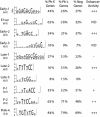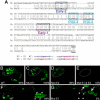Whole-genome analysis of temporal gene expression during foregut development
- PMID: 15492775
- PMCID: PMC523228
- DOI: 10.1371/journal.pbio.0020352
Whole-genome analysis of temporal gene expression during foregut development
Abstract
We have investigated the cis-regulatory network that mediates temporal gene expression during organogenesis. Previous studies demonstrated that the organ selector gene pha-4/FoxA is critical to establish the onset of transcription of Caenorhabditis elegans foregut (pharynx) genes. Here, we discover additional cis-regulatory elements that function in combination with PHA-4. We use a computational approach to identify candidate cis-regulatory sites for genes activated either early or late during pharyngeal development. Analysis of natural or synthetic promoters reveals that six of these sites function in vivo. The newly discovered temporal elements, together with predicted PHA-4 sites, account for the onset of expression of roughly half of the pharyngeal genes examined. Moreover, combinations of temporal elements and PHA-4 sites can be used in genome-wide searches to predict pharyngeal genes, with more than 85% accuracy for their onset of expression. These findings suggest a regulatory code for temporal gene expression during foregut development and provide a means to predict gene expression patterns based solely on genomic sequence.
Conflict of interest statement
The authors have declared that no conflicts of interest exist.
Figures









Similar articles
-
The molecular basis of organ formation: insights from the C. elegans foregut.Annu Rev Cell Dev Biol. 2009;25:597-628. doi: 10.1146/annurev.cellbio.24.110707.175411. Annu Rev Cell Dev Biol. 2009. PMID: 19575642 Free PMC article. Review.
-
Environmentally induced foregut remodeling by PHA-4/FoxA and DAF-12/NHR.Science. 2004 Sep 17;305(5691):1743-6. doi: 10.1126/science.1102216. Science. 2004. PMID: 15375261
-
Regulation of organogenesis by the Caenorhabditis elegans FoxA protein PHA-4.Science. 2002 Feb 1;295(5556):821-5. doi: 10.1126/science.1065175. Science. 2002. PMID: 11823633
-
Dynamic chromatin organization during foregut development mediated by the organ selector gene PHA-4/FoxA.PLoS Genet. 2010 Aug 12;6(8):e1001060. doi: 10.1371/journal.pgen.1001060. PLoS Genet. 2010. PMID: 20714352 Free PMC article.
-
Temporal and spatial patterning of an organ by a single transcription factor.Genome Biol. 2005;6(2):205. doi: 10.1186/gb-2005-6-2-205. Epub 2005 Jan 25. Genome Biol. 2005. PMID: 15693952 Free PMC article. Review.
Cited by
-
Reduction of mRNA export unmasks different tissue sensitivities to low mRNA levels during Caenorhabditis elegans development.PLoS Genet. 2019 Sep 16;15(9):e1008338. doi: 10.1371/journal.pgen.1008338. eCollection 2019 Sep. PLoS Genet. 2019. PMID: 31525188 Free PMC article.
-
Temporal coordination of gene networks by Zelda in the early Drosophila embryo.PLoS Genet. 2011 Oct;7(10):e1002339. doi: 10.1371/journal.pgen.1002339. Epub 2011 Oct 20. PLoS Genet. 2011. PMID: 22028675 Free PMC article.
-
The molecular basis of organ formation: insights from the C. elegans foregut.Annu Rev Cell Dev Biol. 2009;25:597-628. doi: 10.1146/annurev.cellbio.24.110707.175411. Annu Rev Cell Dev Biol. 2009. PMID: 19575642 Free PMC article. Review.
-
The C. elegans tailless/Tlx homolog nhr-67 regulates a stage-specific program of linker cell migration in male gonadogenesis.Development. 2009 Dec;136(23):3907-15. doi: 10.1242/dev.035477. Development. 2009. PMID: 19906858 Free PMC article.
-
Cell interactions and patterned intercalations shape and link epithelial tubes in C. elegans.PLoS Genet. 2013;9(9):e1003772. doi: 10.1371/journal.pgen.1003772. Epub 2013 Sep 5. PLoS Genet. 2013. PMID: 24039608 Free PMC article.
References
-
- Ang SL, Rossant J. HNF-3 beta is essential for node and notochord formation in mouse development. Cell. 1994;78:561–574. - PubMed
-
- Ao W, Gaudet J, Mango SE. Environmentally-induced foregut remodelling is mediated by convergent downstream regulation by PHA-4/FoxA and the DAF-12 nuclear hormone receptor. Science. 2004 In press. - PubMed
-
- Azzaria M, Goszczynski B, Chung MA, Kalb JM, McGhee JD. A fork head/HNF-3 homolog expressed in the pharynx and intestine of the Caenorhabditis elegans embryo. Dev Biol. 1996;178:289–303. - PubMed
-
- Bailey TL, Elkan C. Fitting a mixture model by expectation maximization to discover motifs in biopolymers. Proc Int Conf Intell Syst Mol Biol. 1994;2:28–36. - PubMed
Publication types
MeSH terms
Substances
Grants and funding
LinkOut - more resources
Full Text Sources

